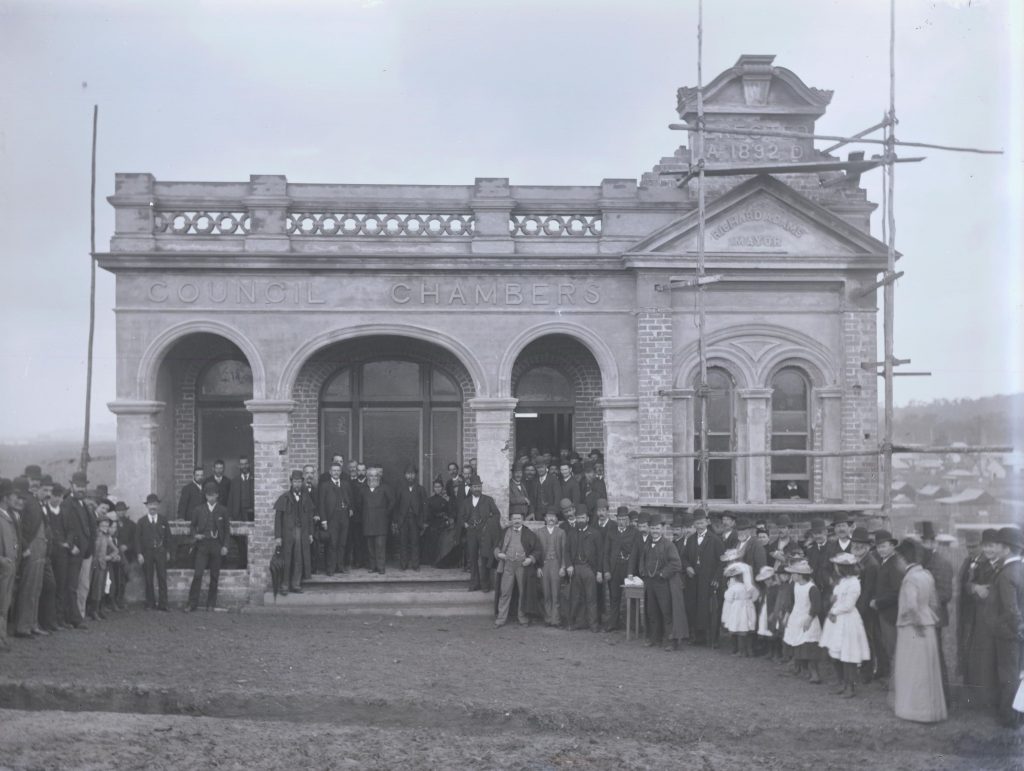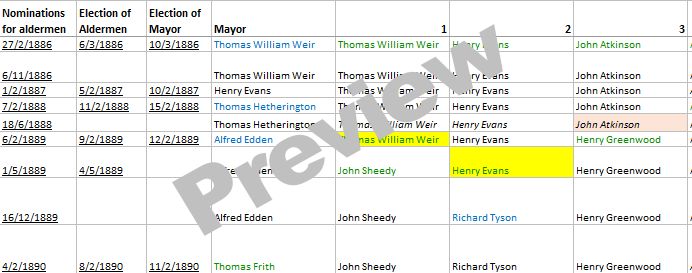Adamstown Council was incorporated on 31 December 1885 and remained until March 1938 when 11 local municipal councils merged to form the City of Greater Newcastle Council. During its 52 years of its existence, Adamstown Council had 84 different aldermen, 32 of whom served as mayor.
The file linked to below contains a summary of all the aldermen that served on New Lambton Municipal Council in the years 1889 to 1938.
Entries in the table that are underlined are hyperlinks to a relevant newspaper article in Trove. To make sense of the information in the summary document, it is helpful to understand how council elections were organised, and how I have used different text and background colours to represent changes in the council membership.

Council elections
Elections in the Adamstown Municipal Council were initially governed by the NSW Municipalities Act of 1867. The council had 9 aldermen, who served terms of three years.
Initially the municipality was incorporated in 1886 without a ward system, but prior to the 1891 election, the municipality was divided into three wards (North/South/East), with three aldermen to represent each ward. Each February the term of three aldermen expired (one from each ward), and nominations were called to fill the expiring positions, so that over a three year cycle the terms of all nine of the aldermen expired. If only one nomination was received for a particular ward, that nominee was automatically elected to the council without the need for a ballot. If there was more than one nomination in a ward the returning officer would set a date within the next seven days at which a ballot would be held, where the ratepayers of the council area would vote for aldermen.
The position of Mayor was not voted on by ratepayers, but rather on the first council meeting after the election, the nine aldermen (including the three newly elected/returned aldermen) would vote for who they wanted to be Mayor. In contrast to the position of aldermen who were elected to a term of three years, the position of Mayor had a term of only one year.
In the event of any casual vacancies, nominations for the vacancy would be called for, and an election called if there were more nominees than vacancies. Casual vacancies in Adamstown were caused by resignation, death, or in the case of the 1920 election, there being a shortage of nominees.
On 26/2/1906, the Municipalities Act (1897) was replaced by the Local Government Act (1906). The system of electing 3 aldermen each year was changed to elect 9 aldermen every 3 years. The election of a Mayor was still held each February, with the Mayoral term running from the first day of March to the last day of February. At a council meeting on 12 March 1919, the aldermen voted to abolish the ward system in Adamstown.
Although there are numerous pieces of legislation relevant to local government in the period 1871 to 1938, the main acts relevant to the content on this page are:
- NSW Municipalities Act (1867)
- Local Government Act (1906)
- Local Government Act (1919)
- City of Greater Newcastle Act (1937)
Colour coding
In the documents I have used different colours to indicate the means by which people entered and exited council positions:
- The foreground text color indicates how a person entered a council position:
- Blue indicates the person was elected unopposed.
- Green indicates the person was a successful candidate in an election.
- Black indicates a continuation in office.
- The background colour of a table cell indicates how a person exited a council position:
- Yellow indicates a resignation.
- Light pink indicates expiration of a term, and the person did not seek re-election.
- Darker pink indicates expiration of a term, and the person was defeated when seeking re-election to another term.
- Light gray indicates that the person died while serving their term of office.
- For entries prior to 1906, where three aldermen retired each year, the names of the retiring aldermen are shown in italics.
Each new row in the table represents a change in the makeup of the council, with the exception of the council/mayoral elections of February 1919, December 1920, December 1921 and December 1935 where the aldermen and mayor remained unchanged.
Miscellaneous Observations
In the period 1886 to 1938:
- 32 different people served as Mayor.
- The longest serving Mayor was Theophilus Robin, who served a total of 5 years as Mayor during the period 1908 to 1917, on three separate occasions.
- Edden St is named after Alfred Edden, who served as Mayor in 1889 and 1891.
- In comparison with Lambton, Adamstown liked to share the Mayoral honours around. Adamstown council operated for 15 years less than Lambton council, but had four more than Lambton’s 28 Mayors.
- 84 different people served as aldermen.
- Often there are variant spellings for the same aldermen. In the spreadsheet I have used a consistent spelling of names, based on the variant that seems to be used the most, and on a separate worksheet listed the variant spellings. The most curious case is that of Matthew Loyden/Lydon, who prior to 12 February 1900 is consistently spelled “Loyden” and after 12 February 1900 is consistently spelled “Lydon”. And on that exact date he is spelled “Loyden” in the Newcastle Morning Herald, and “Lydon” in the Daily Telegraph!
- The longest serving alderman was Matthew Lydon who served a total of 22 years and 6 months in the period 1888 to 1917, on two separate occasions.
- The shortest term of an aldermen was that of R Keogh who filled a casual vacancy for 8 months in 1925.
- This page is titled “Adamstown Aldermen“, for they were all men. For most of the life of the council, this was by law, for while both men and women were entitled to vote, the Municipalities Act of 1867 and the Local Government Act of 1906 was explicit in restricting council service to men. e.g. section 69 of the 1906 act says:
“Any male person whose name is on the roll of electors for an area shall, if not disqualified, be eligible to be elected and to act as alderman or councillor of the area.”
By the time of the Local Government Act of 1919, this gender exclusion for office was no longer in place, however in the remaining 20 years no women were nominated for or elected to Adamstown Council. - Four people died while serving in office, James Gray in 1916, Thomas Rutherford and Matthew Lydon in 1917, and Allan Randolph Cameron in 1936.
- There were 22 occasions when an alderman or mayor resigned their position. In most cases the reason was that the person had left the district, or because of ill health.

